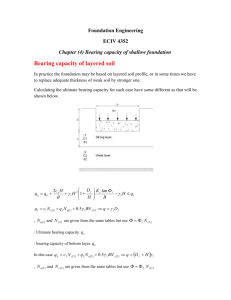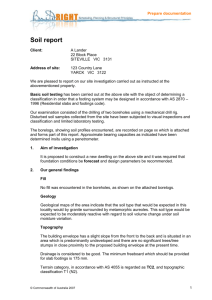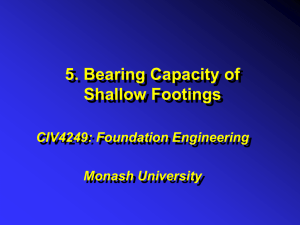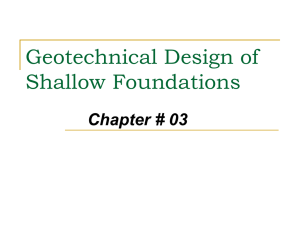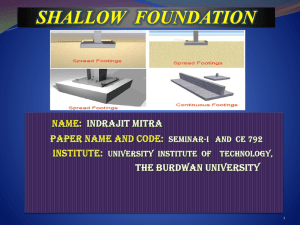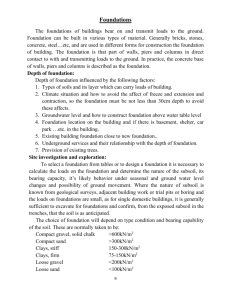bearing capacity of soil - Civil-Team
advertisement
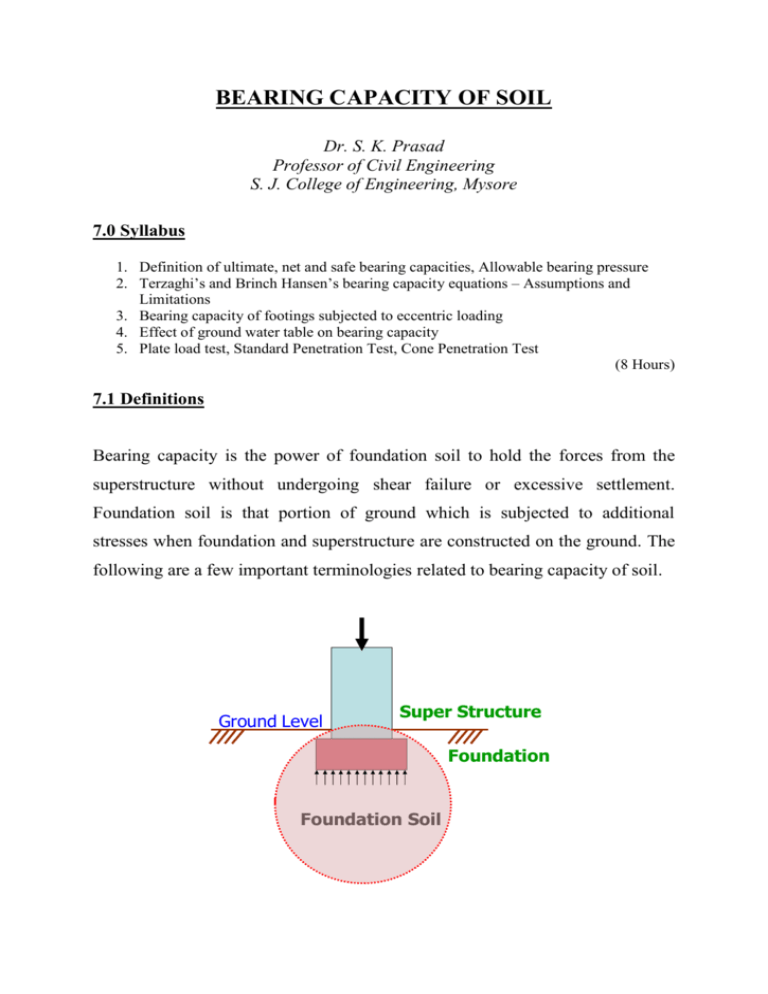
BEARING CAPACITY OF SOIL Dr. S. K. Prasad Professor of Civil Engineering S. J. College of Engineering, Mysore 7.0 Syllabus 1. Definition of ultimate, net and safe bearing capacities, Allowable bearing pressure 2. Terzaghi’s and Brinch Hansen’s bearing capacity equations – Assumptions and Limitations 3. Bearing capacity of footings subjected to eccentric loading 4. Effect of ground water table on bearing capacity 5. Plate load test, Standard Penetration Test, Cone Penetration Test (8 Hours) 7.1 Definitions Bearing capacity is the power of foundation soil to hold the forces from the superstructure without undergoing shear failure or excessive settlement. Foundation soil is that portion of ground which is subjected to additional stresses when foundation and superstructure are constructed on the ground. The following are a few important terminologies related to bearing capacity of soil. Ground Level Super Structure Foundation Foundation Soil Fig. 7.1 : Main components of a structure including soil 7.1.1 Ultimate Bearing Capacity (qf) : It is the maximum pressure that a foundation soil can withstand without undergoing shear failure. 7.1.2 Net ultimate Bearing Capacity (qn) : It is the maximum extra pressure (in addition to initial overburden pressure) that a foundation soil can withstand without undergoing shear failure. qn = q f - qo Here, qo represents the overburden pressure at foundation level and is equal to үD for level ground without surcharge where ү is the unit weight of soil and D is the depth to foundation bottom from Ground Level. 7.1.3 Safe Bearing Capacity (qs) : It is the safe extra load the foundation soil is subjected to in addition to initial overburden pressure. qs qn qo F Here. F represents the factor of safety. 7.1.4 Allowable Bearing Pressure (qa) : It is the maximum pressure the foundation soil is subjected to considering both shear failure and settlement. 7.1.5 Foundation is that part of the structure which is in direct contact with soil. Foundation transfers the forces and moments from the super structure to the soil below such that the stresses in soil are within permissible limits and it provides stability against sliding and overturning to the super structure. It is a transition between the super structure and foundation soil. The job of a geotechnical engineer is to ensure that both foundation and soil below are safe against failure and do not experience excessive settlement. Footing and foundation are synonymous. 7.2 Modes of shear failure Depending on the stiffness of foundation soil and depth of foundation, the following are the modes of shear failure experienced by the foundation soil. 1. General shear failure (Ref Fig. 7.1a) 2. Local shear failure (Ref Fig. 7.1b) 3. Punching shear failure (Ref Fig. 7.1c) Shear failure in foundation soil P – Δ curve in different foundation soils Fig. 7. 1 : Footing on ground that experiences a) General shear failure, b) Local shear failure and c) Punching shear failure 7.2.1 General Shear Failure This type of failure is seen in dense and stiff soil. The following are some characteristics of general shear failure. 1. Continuous, well defined and distinct failure surface develops between the edge of footing and ground surface. 2. Dense or stiff soil that undergoes low compressibility experiences this failure. 3. Continuous bulging of shear mass adjacent to footing is visible. 4. Failure is accompanied by tilting of footing. 5. Failure is sudden and catastrophic with pronounced peak in P – Δ curve. 6. The length of disturbance beyond the edge of footing is large. 7. State of plastic equilibrium is reached initially at the footing edge and spreads gradually downwards and outwards. 8. General shear failure is accompanied by low strain (<5%) in a soil with considerable Φ (Φ>36o) and large N (N > 30) having high relative density (ID > 70%). 7.2.2 Local Shear Failure This type of failure is seen in relatively loose and soft soil. The following are some characteristics of general shear failure. 1. A significant compression of soil below the footing and partial development of plastic equilibrium is observed. 2. Failure is not sudden and there is no tilting of footing. 3. Failure surface does not reach the ground surface and slight bulging of soil around the footing is observed. 4. Failure surface is not well defined. 5. Failure is characterized by considerable settlement. 6. Well defined peak is absent in P – Δ curve. 7. Local shear failure is accompanied by large strain (> 10 to 20%) in a soil with considerably low Φ (Φ<28o) and low N (N < 5) having low relative density (ID > 20%). 7.2.3 Punching Shear Failure This type of failure is seen in loose and soft soil and at deeper elevations. The following are some characteristics of general shear failure. 1. This type of failure occurs in a soil of very high compressibility. 2. Failure pattern is not observed. 3. Bulging of soil around the footing is absent. 4. Failure is characterized by very large settlement. 5. Continuous settlement with no increase in P is observed in P – Δ curve. Fig. 7.2 presents the conditions for different failure modes in sandy soil carrying circular footing based on the contributions from Vesic (1963 & 1973) Fig. 7.2 : Modes of failure at different Relative densities & depths of foundations 7.2.4 Distinction between General Shear & Local or Punching Shear Failures The basic distinctions between general shear failure and punching shear failure are presented in Table 7.1. Table 7.1 : Distinction between General Shear & Local Shear Failures General Shear Failure Local/Punching Shear Failure Occurs in dense/stiff soil Occurs in loose/soft soil Φ>36o, N>30, ID>70%, Cu>100 kPa Φ<28o, N<5, ID<20%, Cu<50 kPa Results in small strain (<5%) Results in large strain (>20%) Failure pattern well defined & clear Failure pattern not well defined Well defined peak in P-Δ curve No peak in P-Δ curve Bulging formed in the neighbourhood of No footing at the surface Extent of horizontal Bulging observed in the neighbourhood of footing spread of Extent of horizontal spread of disturbance at the surface large disturbance at the surface very small Observed in shallow foundations Observed in deep foundations Failure is sudden & catastrophic Failure is gradual Less settlement, but tilting failure Considerable settlement of footing observed observed 7.3 Terzaghi’s bearing Capacity Theory Terzaghi (1943) was the first to propose a comprehensive theory for evaluating the safe bearing capacity of shallow foundation with rough base. 7.3.1 Assumptions 1. Soil is homogeneous and Isotropic. 2. The shear strength of soil is represented by Mohr Coulombs Criteria. 3. The footing is of strip footing type with rough base. It is essentially a two dimensional plane strain problem. 4. Elastic zone has straight boundaries inclined at an angle equal to Φ to the horizontal. 5. Failure zone is not extended above, beyond the base of the footing. Shear resistance of soil above the base of footing is neglected. 6. Method of superposition is valid. 7. Passive pressure force has three components (PPC produced by cohesion, PPq produced by surcharge and PPγ produced by weight of shear zone). 8. Effect of water table is neglected. 9. Footing carries concentric and vertical loads. 10.Footing and ground are horizontal. 11.Limit equilibrium is reached simultaneously at all points. Complete shear failure is mobilized at all points at the same time. 12.The properties of foundation soil do not change during the shear failure 7.3.2 Limitations 1. The theory is applicable to shallow foundations 2. As the soil compresses, Φ increases which is not considered. Hence fully plastic zone may not develop at the assumed Φ. 3. All points need not experience limit equilibrium condition at different loads. 4. Method of superstition is not acceptable in plastic conditions as the ground is near failure zone. Fig. 7.3 : Terzaghi’s concept of Footing with five distinct failure zones in foundation soil 7.3.3 Concept A strip footing of width B gradually compresses the foundation soil underneath due to the vertical load from superstructure. Let qf be the final load at which the foundation soil experiences failure due to the mobilization of plastic equilibrium. The foundation soil fails along the composite failure surface and the region is divided in to five zones, Zone 1 which is elastic, two numbers of Zone 2 which are the zones of radial shear and two zones of Zone 3 which are the zones of linear shear. Considering horizontal force equilibrium and incorporating empirical relation, the equation for ultimate bearing capacity is obtained as follows. Ultimate bearing capacity, q f cN c DN q 0.5BN If the ground is subjected to additional surcharge load q, then q f cN c (D q) N q 0.5BN Net ultimate bearing capacity, q n cN c DN q 0.5BN D q n cN c D( N q 1) 0.5BN Safe bearing capacity, qs cN c D( N q 1) 0.5BN D 1 F Here, F = Factor of safety (usually 3) c = cohesion γ = unit weight of soil D = Depth of foundation q = Surcharge at the ground level B = Width of foundation Nc, Nq, Nγ = Bearing Capacity factors Table 7.2 : Bearing capacity factors for different ϕ ϕ Nc Nq Ng N'c N'q N'g 0 5.7 1.0 0.0 5.7 1.0 0.0 5 7.3 1.6 0.5 6.7 1.4 0.2 10 9.6 2.7 1.2 8.0 1.9 0.5 15 12.9 4.4 2.5 9.7 2.7 0.9 20 17.7 7.4 5.0 11.8 3.9 1.7 25 25.1 12.7 9.7 14.8 5.6 3.2 30 37.2 22.5 19.7 19.0 8.3 5.7 34 52.6 36.5 35.0 23.7 11.7 9.0 35 57.8 41.4 42.4 25.2 12.6 10.1 40 95.7 81.3 100.4 34.9 20.5 18.8 45 172.3 173.3 297.5 51.2 35.1 37.7 48 258.3 287.9 780.1 66.8 50.5 60.4 50 347.6 415.1 1153.2 81.3 65.6 87.1 Fig. 7.4 : Terzaghi’s Bearing Capacity Factors for different ϕ 7.4 Effect of shape of Foundation The shape of footing influences the bearing capacity. Terzaghi and other contributors have suggested the correction to the bearing capacity equation for shapes other than strip footing based on their experimental findings. The following are the corrections for circular, square and rectangular footings. 7.4.1 Circular footing q f 1.3cN c DN q 0.3BN 7.4.2 Square footing q f 1.3cN c DN q 0.4BN 7.4.3 Rectangular footing B B q f (1 0.3 )cN c DN q (1 0.2 )0.5BN L L 7.4.4 Summary of Shape factors Table 7.2 gives the summary of shape factors suggested for strip, square, circular and rectangular footings. B and L represent the width and length respectively of rectangular footing such that B < L. Table 7.3 : Shape factors for different shapes of footing Shape sc sq sγ 1 1 1 Square 1.3 1 0.8 Round 1.3 1 0.6 B (1 0.3 ) L 1 B (1 0.2 ) L Strip Rectangle 7.5 Local shear failure The equation for bearing capacity explained above is applicable for soil experiencing general shear failure. If a soil is relatively loose and soft, it fails in local shear failure. Such a failure is accounted in bearing capacity equation by reducing the magnitudes of strength parameters c and ϕ as follows. tan 1 c1 2 tan 3 2 c 3 Table 7.3 summarizes the bearing capacity factors to be used under different situations. If ϕ is less than 36o and more than 28o, it is not sure whether the failure is of general or local shear type. In such situations, linear interpolation can be made and the region is called mixed zone. Table 7.4 : Bearing capacity factors in zones of local, mixed and general shear conditions. Local Shear Failure Mixed Zone General Shear Failure Φ < 28o 28o < ϕ < 36o Φ > 36o Nc1, Nq1, Nγ1 Ncm, Nqm, Nγm Nc, Nq, Nγ 7.6 Effect of Water Table fluctuation The basic theory of bearing capacity is derived by assuming the water table to be at great depth below and not interfering with the foundation. However, the presence of water table at foundation depth affects the strength of soil. Further, the unit weight of soil to be considered in the presence of water table is submerged density and not dry density. Hence, the reduction coefficients R W1 and RW2 are used in second and third terms of bearing capacity equation to consider the effects of water table. Influence of RW1 ZW1 D B 0.5 < RW1 < 1 B ZW2 B Influence of RW2 D Fig. 7.5 : Effect of water table on bearing capacity Ultimate bearing capacity with the effect of water table is given by, q f cN c DN q Rw1 0.5BN Rw 2 1 Z Here, Rw1 1 w1 2 D where ZW1 is the depth of water table from ground level. 1. 0.5<Rw1<1 2. When water table is at the ground level (Zw1 = 0), Rw1 = 0.5 3. When water table is at the base of foundation (Zw1 = D), Rw1 = 1 4. At any other intermediate level, Rw1 lies between 0.5 and 1 1 Z Here, Rw2 1 w2 2 B where ZW2 is the depth of water table from foundation level. 1. 0.5<Rw2<1 2. When water table is at the base of foundation (Zw2 = 0), Rw2 = 0.5 3. When water table is at a depth B and beyond from the base of foundation (Zw2 >= B), Rw2 = 1 4. At any other intermediate level, Rw2 lies between 0.5 and 1 7.7 Effect of eccentric foundation base DD DD Resultant of superstructure pressure Concentric e Eccentric B Fig. 7.6 : Effect of eccentric footing on bearing capacity The bearing capacity equation is developed with the idealization that the load on the foundation is concentric. However, the forces on the foundation may be eccentric or foundation may be subjected to additional moment. In such situations, the width of foundation B shall be considered as follows. B 1 B 2e If the loads are eccentric in both the directions, then B1 B 2eB & L1 L 2e L Further, area of foundation to be considered for safe load carried by foundation is not the actual area, but the effective area as follows. A1 B1 XL1 In the calculation of bearing capacity, width to be considered is B1 where B1 < L1. Hence the effect of provision of eccentric footing is to reduce the bearing capacity and load carrying capacity of footing. 7.8 Factor of Safety It is the factor of ignorance about the soil under consideration. It depends on many factors such as, 1. Type of soil 2. Method of exploration 3. Level of Uncertainty in Soil Strength 4. Importance of structure and consequences of failure 5. Likelihood of design load occurrence, etc. Assume a factor of safety F = 3, unless otherwise specified for bearing capacity problems. Table 7.5 provides the details of factors of safety to be used under different circumstances. Table 7.5 Typical factors of safety for bearing capacity calculation in different situations 7.9 Density of soil : In geotechnical engineering, one deals with several densities such as dry density, bulk density, saturated density and submerged density. There will always be a doubt in the students mind as to which density to use in a particular case. In case of Bearing capacity problems, the following methodology may be adopted. 1. Always use dry density as it does not change with season and it is always smaller than bulk or saturated density. 2. If only one density is specified in the problem, assume it as dry density and use. 3. If the water table correction is to be applied, use saturated density in stead of dry density. On portions above the water table, use dry density. 4. If water table is some where in between, use equivalent density as follows. In the case shown in Fig. 7a, γeq should be used for the second term and γsat for the third term. In the case shown in Fig. 7b, γ d should be used for second term and γeq for the third term.. eq 1 D1 2 D2 D1 D2 D1 D D2 B (a) Water table above base B (b)Water table below base Fig. 7.7 : Evaluation of equivalent density 7.10 : Factors influencing Bearing Capacity Bearing capacity of soil depends on many factors. The following are some important ones. 1. Type of soil 2. Unit weight of soil 3. Surcharge load 4. Depth of foundation 5. Mode of failure 6. Size of footing 7. Shape of footing 8. Depth of water table 9. Eccentricity in footing load 10.Inclination of footing load 11.Inclination of ground 12.Inclination of base of foundation 7.11 Brinch Hansen’s Bearing Capacity equation As mentioned in previous section, bearing capacity depends on many factors and Terzaghi’s bearing capacity equation doers not take in to consideration all the factors. Brinch Hansen and several other researchers have provided a comprehensive equation for the determination bearing capacity called Generalised Bearing Capacity equation considering the almost all the factors mentioned above. The equation for ultimate bearing capacity is as follows from the comprehensive theory. q f cN c s c d c i c qN q s q d q iq 0.5BN s d i Here, the bearing capacity factors are given by the following expressions which depend on ϕ. N c ( N q 1) cot N q (e tan ) tan 2 (45 ) 2 N 1.5( N q 1) tan Equations are available for shape factors (sc, sq, sγ), depth factors (dc, dq, dγ) and load inclination factors (ic, iq, iγ). The effects of these factors is to reduce the bearing capacity. 7.11 Determination of Bearing Capacity from field tests Field Tests are performed in the field. You have understood the advantages of field tests over laboratory tests for obtaining the desired property of soil. The biggest advantages are that there is no need to extract soil sample and the conditions during testing are identical to the actual situation. Major advantages of field tests are Sampling not required Soil disturbance minimum Major disadvantages of field tests are Labourious Time consuming Heavy equipment to be carried to field Short duration behavior 7.11.1 Plate Load Test Sand Bags Platform for loading Dial Gauge Testing Plate Foundation Level Foundation Soil Fig. 7.8 : typical set up for Plate Load test assembly 1. It is a field test for the determination of bearing capacity and settlement characteristics of ground in field at the foundation level. 2. The test involves preparing a test pit up to the desired foundation level. 3. A rigid steel plate, round or square in shape, 300 mm to 750 mm in size, 25 mm thick acts as model footing. 4. Dial gauges, at least 2, of required accuracy (0.002 mm) are placed on plate on plate at corners to measure the vertical deflection. 5. Loading is provided either as gravity loading or as reaction loading. For smaller loads gravity loading is acceptable where sand bags apply the load. 6. In reaction loading, a reaction truss or beam is anchored to the ground. A hydraulic jack applies the reaction load. 7. At every applied load, the plate settles gradually. The dial gauge readings are recorded after the settlement reduces to least count of gauge (0.002 mm) & average settlement of 2 or more gauges is recorded. 8. Load Vs settlement graph is plotted as shown. Load (P) is plotted on the horizontal scale and settlement (Δ) is plotted on the vertical scale. 9. Red curve indicates the general shear failure & the blue one indicates the local or punching shear failure. 10.The maximum load at which the shear failure occurs gives the ultimate bearing capacity of soil. Reference can be made to IS 1888 - 1982. The advantages of Plate Load Test are 1. It provides the allowable bearing pressure at the location considering both shear failure and settlement. 2. Being a field test, there is no requirement of extracting soil samples. 3. The loading techniques and other arrangements for field testing are identical to the actual conditions in the field. 4. It is a fast method of estimating ABP and P – Δ behaviour of ground. The disadvantages of Plate Load Test are 1. The test results reflect the behaviour of soil below the plate (for a distance of ~2Bp), not that of actual footing which is generally very large. 2. It is essentially a short duration test. Hence, it does not reflect the long term consolidation settlement of clayey soil. 3. Size effect is pronounced in granular soil. Correction for size effect is essential in such soils. 4. It is a cumbersome procedure to carry equipment, apply huge load and carry out testing for several days in the tough field environment. 7.11.2 Standard Penetration Test 65 kg Hammer 750 mm Tripod Bore Hole Split Spoon Sampler Fig. 7.8 : typical set up for Standard Penetration test assembly 1. Reference can be made to IS 2131 – 1981 for details on Standard Penetration Test. 2. It is a field test to estimate the penetration resistance of soil. 3. It consists of a split spoon sampler 50.8 mm OD, 35 mm ID, min 600 mm long and 63.5 kg hammer freely dropped from a height of 750 mm. 4. Test is performed on a clean hole 50 mm to 150 mm in diameter. 5. Split spoon sampler is placed vertically in the hole, allowed to freely settle under its own weight or with blows for first 150 mm which is called seating drive. 6. The number of blows required for the next 300 mm penetration into the ground is the standard penetration number N 7. Apply the desired corrections (such as corrections for overburden pressure, saturated fine silt and energy) 8. N is correlated with most properties of soil such as friction angle, undrained cohesion, density etc. Advantages of Standard Penetration Test are 1. Relatively quick & simple to perform 2. Equipment & expertise for test is widely available 3. Provides representative soil sample 4. Provides useful index for relative strength & compressibility of soil 5. Able to penetrate dense & stiff layers 6. Results reflect soil density, fabric, stress strain behavior 7. Numerous case histories available Disadvantages of Standard Penetration Test are 1. Requires the preparation of bore hole. 2. Dynamic effort is related to mostly static performance 3. SPT is abused, standards regarding energy are not uniform 4. If hard stone is encountered, difficult to obtain reliable result. 5. Test procedure is tedious and requires heavy equipment. 6. Not possible to obtain properties continuously with depth. 7.11.3 Cone Penetration Test Fig. 7.9 : typical set up for Static Cone Penetration test assembly 1. Reference can be made to IS 4968 (P3) – 1987 for details on Standard Penetration Test. 2. Cone Penetration Test can either be Static Cone Penetration Test or Dynamic Cone Penetration Test. 3. Continuous record of penetration resistance with depth is achieved. 4. Consists of a cone 36 mm dia (1000 mm2) and 60o vertex angle. 5. Cone is carried at the lower end of steel rod that passes through steel tube of 36 mm dia. 6. Either the cone, or the tube or both can be forced in to the soil by jacks. 7. Cone is pushed 80 mm in to the ground and resistance is recorded, steel tube is pushed up to the cone and resistance is recorded. Further, both cone and tube are penetrated 200 mm and resistance is recorded. Total resistance (qc) gives the CPT value expressed in kPa. 8. Cone resistance represents bearing resistance at the base and tube resistance gives the skin frictional resistance. Total resistance can be correlated with strength properties, density and deformation characteristics of soil. 9. Correction for overburden pressure is applied. 10.Approximately, N = 10qc (kPa) Advantages of SCPT are 1. Continuous resistance with depth is recorded. 2. Static resistance is more appropriate to determine static properties of soil. 3. Can be correlated with most properties of soil. Disadvantages of SCPT are 1. Not very popular in India. 2. If a small rock piece is encountered, resistance shown is erratic & incorrect. 3. Involves handling heavy equipment. 7.12 Presumptive Safe Bearing Capacity It is the bearing capacity that can be presumed in the absence of data based on visual identification at the site. National Building Code of India (1983) lists the values of presumptive SBC in kPa for different soils as presented below. A : Rocks Sl No 1 2 3 Description SBC (kPa) Rocks (hard) without laminations and defects. For e.g. granite, trap & diorite Laminated Rocks. For e.g. Sand stone and Lime stone in sound condition Residual deposits of shattered and broken bed rocks and hard shale cemented material 3240 1620 880 4 Soft Rock 440 B : Cohesionless Soils Sl No 1 2 3 4 5 6 Description SBC (kPa) Gravel, sand and gravel, compact and offering resistance to penetration when excavated by tools Coarse sand, compact and dry Medium sand, compact and dry Fine sand, silt (dry lumps easily pulverized by fingers) Loose gravel or sand gravel mixture, Loose coarse to medium sand, dry Fine sand, loose and dry 440 440 245 150 245 100 C : Cohesive Soils Sl No 1 2 3 4 5 6 Description SBC (kPa) Soft shale, hard or stiff clay in deep bed, dry Medium clay readily indented with a thumb nail Moist clay and sand clay mixture which can be indented with strong thumb pressure Soft clay indented with moderate thumb pressure Very soft clay which can be penetrated several centimeters with the thumb Black cotton soil or other shrinkable or expansive clay in dry condition (50 % saturation) 440 245 150 100 50 130 - 160 Note : 1. Use γd for all cases without water. Use γsat for calculations with water. If simply density is mentioned use accordingly. 2. Fill all the available data with proper units. 3. Write down the required formula 4. If the given soil is sand, c = 0 7.12 Problems & Solutions 1. A square footing is to be constructed on a deep deposit of sand at a depth of 0.9 m to carry a design load of 300 kN with a factor of safety of 2.5. The ground water table may rise to the ground level during rainy season. Design the plan dimension of footing given γsat = 20.8 kN/m3, Nc = 25, Nq = 34 and Nγ =32. (Feb 2002) Data C=0 F = 2.5 D = 0.9 m RW1 = RW2 = 0.5 γ = 20.8 kN/m3 Nc = 25 Nq = 34 Nγ = 32 qs P P 1 2 1.3cN c D( N q 1) RW 1 0.4BN RW 2 D A B F 300 142.272 B 2 53.249 B 3 B = 1.21 m 2. What will be the net ultimate bearing capacity of sand having ϕ = 36o and γd = 19 kN/m3 for (i) 1.5 m strip foundation and (ii) 1.5 m X 1.5 m square footing. The footings are placed at a depth of 1.5 m below ground level. Assume F = 2.5. Use Terzaghi’s equations. (Aug 2003) ϕ Nc Nq Nγ 35o 57.8 41.4 42.4 40o 95.7 81.3 100.4 By linear interpolation Nc = 65.38, Nq = 49.38, Nγ = 54 at ϕ = 36o Data B = 1.5 m D = 1.5 m γ = 19 kN/m3 Strip Footing q n cN c D( N q 1) 0.5BN qn = 2148.33 kPa Square Footing q n 1.3cN c D( N q 1) 0.4BN qn = 1994.43 kPa 3. A square footing 2.5 m X 2.5 m is built on a homogeneous bed of sand of density 19 kN/m3 having an angle of shearing resistance of 36o. The depth of foundation is 1.5 m below the ground surface. Calculate the safe load that can be applied on the footing with a factor of safety of 3. Take bearing capacity factors as Nc= 27, Nq = 30, Nγ = 35. (Feb 2004) Data C=0 F=3 B = 2.5 m D = 1.5 m γ = 19 kN/m3 Nc = 27 Nq = 30 Nγ = 35 qs P P 1 2 1.3cN c D( N q 1) RW 1 0.4BN RW 2 D A B F Safe load, P = qs*B*B = 3285.4 kN 4. A strip footing 2 m wide carries a load intensity of 400 kPa at a depth of 1.2 m in sand. The saturated unit weight of sand is 19.5 kN/m3 and unit weight above water table is 16.8 kN/m3. If c = 0 and ϕ = 35o, determine the factor of safety with respect to shear failure for the following locations of water table. a. Water table is 4 m below Ground Level b. Water table is 1.2 m below Ground Level c. Water table is 2.5 m below Ground Level d. Water table is at Ground Level. Using Terzaghi’s equation, take Nq = 41.4 and Nγ = 42.4. (Feb 2005) Data C=0 ϕ = 35o B=2m D = 1.2 m γb = 19.5 kN/m3 (bottom) γt = 16.8 kN/m3 (top) Nc = 0 Nq = 41.4 Nγ = 42.4 Safe load intensity = 400 kPa q s 400 cN c D( N q 1) RW 1 0.5BN RW 2 F1 D a. Water table is 4 m below Ground Level RW1 = RW2 = 1 γ = 16.8 kN/m3 F = 4.02 b. Water table is 1.2 m below Ground Level RW1 = 1, RW2 = 0.5 400 16.8 X 1.2 X 40.4 X 1 0.5 X 19.5 X 2 X 42.4 X 0.5 F = 3.227 c. Water table is 2.5 m below Ground Level RW2 = 0.5(1+1.3/2) = 0.825 eff 16.8 X 1.3 19.5 X 0.7 17.745 kN/m3 2 1 16.8 X 1.2 F 400 16.8 X 1.2 X 40.4 X 1 0.5 X 17.745 X 2 X 42.4 X 0.825 1 16.8 X 1.2 F F = 3.779 d. Water table is at Ground Level RW1 = RW2 = 0.5 γ = 19.5 kN/m3 400 19.5 X 1.2 X 40.4 X 0.5 0.5 X 19.5 X 2 X 42.4 X 0.5 1 19.5 X 1.2 F F = 2.353 5. A square footing located at a depth of 1.3 m below ground has to carry a safe load of 800 kN. Find the size of footing if the desired factor of safety is 3. Use Terzaghi’s analysis for general shear failure. Take c = 8 kPa, N c = 37.2, Nq = 22.5, Nγ = 19.7. (Aug 2005) γd = 18 kN/m3 (Assumed) c = 8 kPa F=3 D = 1.3 m Nc = 37.2 Nq = 22.5 Nγ = 19.7 P = 800 kN RW1 = RW2 = 1 qs P P 1 2 1.3cN c D( N q 1) RW 1 0.4BN RW 2 D A B F 47.28B 3 320.06 B 2 800 0 B = 1.436 m 6. A square footing 2.8 m X 2.8 m is built on a homogeneous bed of sand of density 18 kN/m3 and ϕ = 36o. If the depth of foundation is 1.8 m, determine the safe load that can be applied on the footing. Take F = 2.5, Nc = 27, Nq = 36, Nγ = 35. (Feb 2007) Data γd = 18 kN/m3 c = 0 (sand) F = 2.5 B = 2.8 m D = 1.8 m Nc = 27 Nq = 36 Nγ = 35 P=? RW1 = RW2 = 1 qs P P 1 2 1.3cN c D( N q 1) RW 1 0.4BN RW 2 D A B F P = qs*B*B = 6023 kN 7. A strip footing 1 m wide and a square footing 1 m side are placed at a depth of 1 m below the ground surface. The foundation soil has cohesion of 10 kPa, angle of friction of 26o and unit weight of 18 kN/m3. Taking bearing capacity factor from the following table, calculate the safe bearing capacity using Terzaghi’s theory. Use factor of safety of 3. (July 2008) ϕ Nc Nq Nγ 15o 12.9 4.4 2.5 20o 17.7 7.0 5.0 25o 25.1 12.7 9.7 As ϕ = 28o, the ground experiences local shear failure C’ = (2/3)X10 = 6.67 kPa tan ϕ’ = (2/3) X tan ϕ ϕ’ = 18.01o By linear interpolation, Nc’=15.79, Nq’=5.97, Nγ’=4.01 B=1m D=1m γ= 18 kN/m3 Strip footing q s cN c D( N q 1) 0.5BN F1 D =94.96 kPa Square footing q s 1.3cN c D( N q 1) 0.4BN F1 D =103.08 kPa 8. A square footing placed at a depth of 1 m is required to carry a load of 1000 kN. Find the required size of footing given the following data. C = 10 kPa, ϕ = 38o, γ = 19 kN/m3, Nc = 61.35, Nq = 48.93, Nγ = 74.03 and F = 3. Assume water table is at the base of footing. (July 2007) Data C = 10 kPa ϕ = 38o B=? D=1m γ = 19 kN/m3 Nc = 61.35 Nq = 48.93 Nγ = 74.03 F=3 RW1 = 1 RW2 = 0.5 qs P P 1 2 1.3cN c D( N q 1) RW 1 0.4BN RW 2 D A B F B 3 6.14 B 2 3.56 0 B = 0.72 m 7.13 Exercise problems 1. Calculate the ultimate bearing capacity of 2 m wide square footing resting on the ground surface of sand deposit with the following properties; unit weight 18.6 kN/m3, angle of internal friction 35o, Nq = 41.4, Nγ = 42.2. Also calculate ultimate bearing capacity if same footing is placed at a depth of 1 m below ground surface. (July 2006) 2. Determine the safe bearing capacity of a square footing 2.1 m X 2.1 m placed at a depth of 1.5 m in a soil with a moist unit weight of 17.5 kN/m3, c = 15 kPa and ϕ = 20o. Take Nc’=11.8, Nq’ = 3.9 and Nγ’ = 1.7. What is the change in safe bearing capacity if the water table rises to 0.5 m above footing base if F = 3. (July 2002) 3. What will be the gross net bearing capacity of sand having ϕ = 36o and dry unit weight of 19 kN/m3 for the following cases a. 1.5 m wide strip foundation b. 1.5 m X 1.5 m square footing c. 0.75 m radius circular footing The footings are placed at a depth of 1.5 m from ground surface. Assume factor of safety of 1.5 and use Terzaghi’s bearing capacity equations ϕ Nc Nq Nγ 35 57.8 41.4 42.4 40 95.7 81.3 100.4 4. Design a square footing to carry a load of 1500 kN. Assume cohesionless soil and adopt γ = 19 kN/m3, ϕ = 38o, Nq = 49, Nγ = 44.1 and D = 1.5 m, F =3. (Feb 2009) 5. A square footing 1.4 m X 1.4 m rests at a depth of 1 m in a saturated clay layer 3 m deep. Take γsat = 17.8 kN/m3, Nc = 5.7, Nq = 1, F = 2.5. Determine the safe load if the unconfined compressive strength is 50 kPa. 6. A square footing 2m X 2m in plan and 1.5 m below ground level is eccentrically loaded. The resultant is 0.2 m outside of centroid in one direction. If c = 10 kPa, ϕ = 40o, γ=16kN/m3, find the safe load carried by footing. What would have been the increase in load carried, if the load was concentric. ϕ Nc Nq Nγ 40 95.7 81.3 100.4 7. A 3 m X 4 m rectangular footing and 1.5 m below ground level is eccentrically loaded. The resultant is 0.2 m outside of centroid widthwise, and 0.3 m outside of centroid lengthwise. If c = 10 kPa, ϕ = 40o, γ=16kN/m3, find the safe load carried by footing. What would have been the increase in load carried, if the load was concentric. ϕ Nc Nq Nγ 40 95.7 81.3 100.4 8. A 3 m X 4 m rectangular footing is eccentrically loaded. The resultant is 0.2 m outside of centroid widthwise, and 0.3 m outside of centroid lengthwise. If c = 10 kPa, ϕ = 25o, γ=16kN/m3, find the safe load carried by footing. What would have been the increase in load carried, if the load was concentric. Refer to IS 6403-1981 for bearing capacity factors. Note : As ϕ < 28o, the mode of failure is local shear failure. Hence correction for bearing capacity factors and c are necessary 9. A circular footing is proposed on a cohesive ground with c = 8 kPa, ϕ = 30o, and γ = 16.5 kN/m3. Find the safe load carried by the footing if the diameter is 2.5 m. Refer to IS 6403-1981 for bearing capacity factors. 10.A square footing is proposed at a site to carry a load of 600 kN. The standard penetration test indicated that the average N value after all the corrections was 30 and the ground was granular. Design the size of footing. Refer to IS 6403-1981 11.The following are the results of plate load test on granular soil. P (kN) 5 10 20 30 40 50 60 Δ (mm) 0.15 0.3 0.62 0.91 1.22 3.85 7.67 Find the allowable bearing pressure if B = 2 m, Bp = 0.3 m, permissible settlement in field = 12 mm. 12.The following are the results of plate load test on cohesive soil. P (kN) 5 10 20 30 40 50 60 Δ (mm) 0.15 0.3 0.62 0.91 1.22 3.85 7.67 Find the allowable bearing pressure if B = 2 m, Bp = 0.3 m, permissible settlement in field = 12 mm. 13.Find the safe bearing capacity of soil to support a 2 m X 3 m footing at a depth of 1.8 m when the load is inclined at 10 o to vertical. Take c = 10 kPa, ϕ = 25o, γ=16 kN/m3. Find the safe load carried by the footing. Find the safe load supported by the footing if eccentricities of 0.1 m widthwise and 0.12 m lengthwise exist. Further, find the drop in safe load carried if water table rises up to the base of footing. 14.A 2 m X 2 m square footing is proposed on a ground with c = 8 kPa, ϕ = 38o, γ = 18 kN/m3 at a depth of 1.5 m. If Nc = 61.35, Nq = 48.93, Nγ = 74.03, find the safe bearing capacity of soil in different seasons of the year. The depth of Ground Water Table below Ground Level in January, March, May, July, September and November are respectively 4 m, 6 m, 0 m, 1 m, 1.5 m, 2.5 m. 7.14 Additional Questions 1) List the advantages and disadvantages of plate load test 2) Distinguish between Standard Penetration Test and Static cone penetration test 3) Distinguish between Static cone penetration test and dynamic cone penetration test 4) Distinguish between Standard Penetration Test and dynamic cone penetration test 5) Distinguish general shear failure from local shear failure 6) List the assumptions of Terzaghi’s bearing capacity theory 7) Mention the limitations of Terzaghi’s bearing capacity theory 8) Explain the effect of shape of footing on bearing capacity 9) How does ground water table influence bearing capacity? Explain 10) Eccentrically placed footings perform better than concentrically placed footings. Is the statement true or false ? Justify your answer. 11) Explain the effect of eccentricity of footing on its load carrying capacity. Describe the influence of one way and two way eccentricities. 12) What is the influence of size of footing on cohesive soils ? 13) How do you consider local shear effect in bearing capacity equation ? 14) What are the advantages of Brinch Hansen’s Theory over Terzaghi’s theory of bearing capacity ? 15) Distinguish Safe Bearing Capacity from Allowable Bearing Pressure 16) Distinguish Safe Bearing Capacity from Ultimate Bearing Capacity 17) Briefly explain Terzaghi’s bearing capacity theory 18) Briefly explain Brinch Hansen’s bearing capacity theory 19) A granular soil possesses ϕ = 30o. Explain the procedure adopted to evaluate Safe Bearing Capacity. 20) How do you determine Safe Bearing Capacity at a site ? Explain. 21) Explain which unit weight of soil should be used in bearing capacity determination. Justify your answer. 22) A footing is designed to carry a specific load of superstructure. It is decided to redesign the same to carry double the load. What actions would you take? 23) Discuss the factors influencing bearing capacity of soil 24) Explain the test procedure for conducting plate load test as per Indian Standards 25) Explain the test procedure for conducting Standard Penetration test as per Indian Standards 26) Explain the test procedure for conducting Static Cone Penetration test as per Indian Standards 27) Explain the test procedure for conducting Dynamic Cone Penetration test as per Indian Standards 28) How do you interpret field test results for the determination of Safe Bearing Capacity required for foundation design ? 29) Write short notes on a. Plate load test b. Standard Penetration test c. Static Cone Penetration test d. Dynamic Cone Penetration test e. Local shear failure f. General shear failure g. Punching shear failure h. Effect of Ground Water Table on bearing capacity i. Shape of footing j. Eccentric load on footing 7.15 References 1. Bowles, J. E. (1977) “Foundation Analysis and Design”, Mc Graw Hill Publications, New York. 2. Craig, R. F. (1983) “Soil Mechanics”, 3rd Edition, English Language Book Society & Van nostrand Reinhold Co. Ltd., London. 3. Das, B. M. (2007) “Principles of Foundation Engineering”, Thomson India Edition, New Delhi. 4. IS6403-1981 5. Punmia, B. C. (2005) “Soil Mechanics and Foundations”, Laxmi Publications Pvt. Ltd., Bangalore 6. Som, N. N. and Das, S. C. (2003) “Theory and Practice of Foundation Design”, Prentice Hall of India, New Delhi
